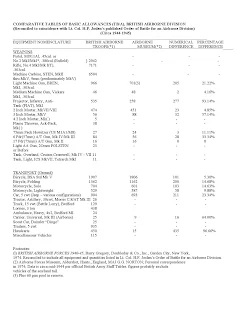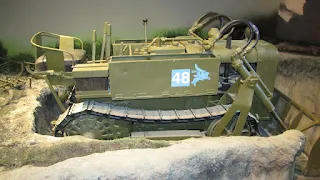Having written the previous article on the arms and equipment of a World War II British Airborne Division, this author reviewed the orders of battle for those divisions available on the Internet. There are some very good ones, and I have listed one of the best in the Links section of this blog, however it seemed as though all of them lacked certain elements of information.
Early in my evolving interest in the British 1st Airborne Division at the battle of Arnhem I compiled an expanded and annotated Order of Battle (OOB)/Table of Basic Allowances (T B/A) of the Division. Given my then very limited knowledge of the battle, I submitted my preliminary efforts to the staff of the Airborne Forces Museum, which was co-located with their Headquarters and Depot, Aldershot, Hampshire. It's reasonably comprehensive, and although far from perfect, it does incorporate some features not found elsewhere. Where there are identified errors or incompleteness, hopefully they have been identified.
Early in my evolving interest in the British 1st Airborne Division at the battle of Arnhem I compiled an expanded and annotated Order of Battle (OOB)/Table of Basic Allowances (T B/A) of the Division. Given my then very limited knowledge of the battle, I submitted my preliminary efforts to the staff of the Airborne Forces Museum, which was co-located with their Headquarters and Depot, Aldershot, Hampshire. It's reasonably comprehensive, and although far from perfect, it does incorporate some features not found elsewhere. Where there are identified errors or incompleteness, hopefully they have been identified.
It was 1974 and the epic
film adaptation of Cornelius Ryan’s book “A Bridge Too Far” was yet to be
produced, however the book had become a best seller. Maj Geoff G. Norton, the
then curator of the museum, was gracious enough to personally respond to my
request to review and correct my efforts to that point in time. I think that
because the query was coming from a “colonial”, and a reserve naval
intelligence officer of senior rank, must have captured his interest and attention. At the
time he was a busy man, also serving as Second-in-Command of the Depot of the
Parachute Regiment and Airborne Forces. In addition, he himself had already authored a book
in the “Famous Regiments” series, “The
Red Devils”, in 1971. See; Norton, G.G., The Red Devils (The Story of British Airborne Forces), Leo Cooper Ltd, London, 1971, ISBN 0 85052 045 2. Given his detailed knowledge and encouragement, I
continued to expand and refine my efforts.
As already pointed out in
the immediately previous blog article, http://arnhemjim.blogspot.com/2017/07/detailed-list-of-arms-and-equipment-of.html, there is a disparity with regard to quantities of
items in allowance as given in Lt Col H.F. Joslen’s book, Orders of Battle,
Second World War,1939 -1945, Her Majesty’s Stationary Office, 1960. When
compiling the list of arms and equipment I was not aware of Lt Col Joslen’s
book. Nor do I know whether Maj Norton had access to the book. In his
correspondence Maj Norton cites as his source British Army Staff Tables (1944)
for an Airborne Division’s weapons. Two of the principal differences in the two lists
is in the increase of anti-tank weapons (6 pdrs and PIATs) and jeeps. Given the
significantly improved capabilities of German armor late in the war, combined
with the combat established need to improve ground mobility for the paratroops, the author would give
more credence to the higher numbers. The author personally concludes that the
higher numbers are more likely to be correct. An attempt to
reconcile all the discrepancies has been attempted, and is included in addition to the original analysis developed
in 1974.
Keen eyes will also discern the
author’s limited knowledge at the time, such as the
erroneous inclusion of the Inglis Browning 9mm pistol and Wireless Set, No. 38 in
the equipment list, the omission of the Morris artillery tractors for the 17 pdr anti-tank
guns, and the lack of personnel numbers for the 6080 and 6341 Light Warning Units of
the RAF (at least I was aware of their existence). Suffices the author has learned quite a
bit since those early efforts, and hopefully that knowledge has been conveyed in this and
other articles contained in this blog.
erroneous inclusion of the Inglis Browning 9mm pistol and Wireless Set, No. 38 in
the equipment list, the omission of the Morris artillery tractors for the 17 pdr anti-tank
guns, and the lack of personnel numbers for the 6080 and 6341 Light Warning Units of
the RAF (at least I was aware of their existence). Suffices the author has learned quite a
bit since those early efforts, and hopefully that knowledge has been conveyed in this and
other articles contained in this blog.
To the best of my knowledge all the other
names and numbers are correct to the extent of known official archives. Having diligently attempted to edit the tables for alignment of the columns, if there are any remaining ambiguities, please advise the author in the Comments.
Editorial note: Although previously unknown to the author the following piece of equipment which should be added, and was flown in by Horsa glider and employed by the Royal Engineers in Operation Market Garden was an American Machine and Metals, Inc., Tractor, Crawler, Gasoline, Clark CA-1 bulldozer.
Editorial note: Although previously unknown to the author the following piece of equipment which should be added, and was flown in by Horsa glider and employed by the Royal Engineers in Operation Market Garden was an American Machine and Metals, Inc., Tractor, Crawler, Gasoline, Clark CA-1 bulldozer.
















